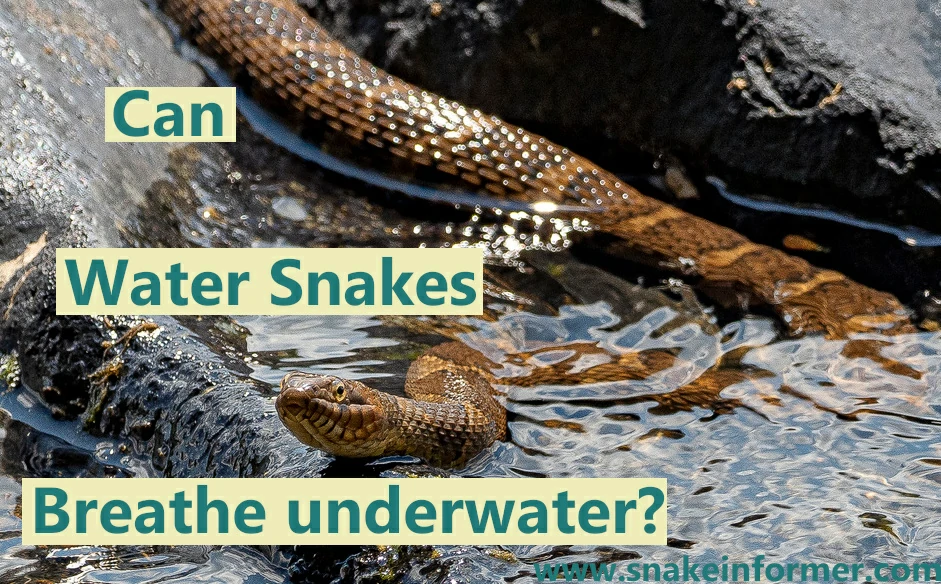There are many different species of snakes called ‘water snakes’, among them the common watersnake (Nerodia sipedon) native to North America, and the common grass snake (Natrix natrix) native to Europe and western Asia.
Water snakes are characterized by their semi-aquatic lifestyle, and spend a significant time in or near freshwater bodies such as rivers, swamps, or lakes.
In general, water snakes can not breathe underwater, but they can hold their breath for long periods of time. How long a particular water snake can stay underwater depends on the species and level of activity.
An inactive water snake may be able to stay underwater for several hours. An individual that is hunting, on the other hand, may need to surface more frequently.
Water Snakes Have Lungs and Breathe Air
Like all reptiles, water snakes have lungs, that they use to breathe air.
Due to their elongated bodies, snakes do not have lungs that are located side to side, like ours.
Instead, they have one shorter and one very long lung in a series. In most species, the left lung is the smaller one and is roughly 85% of the length of the elongated right lung.
Some species only have one elongated lung, and the smaller lung is absent.
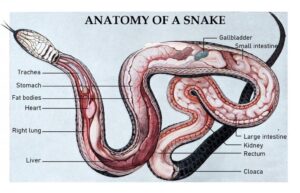
In many snakes, the smaller left lung is vestigial, and all gas exchange happens with the longer lung.
How Snakes Breathe
To breathe, snakes take air down into their lung (s). Once the air is in the lungs, oxygen from the air is then absorbed into the snake’s bloodstream. At the same time, carbon dioxide from the bloodstream is diffused into the air.
That said, it’s important to note that snakes do not possess a diaphragm, to move air in and out of their lungs, as mammals do.
Instead, they respire using their ribs.
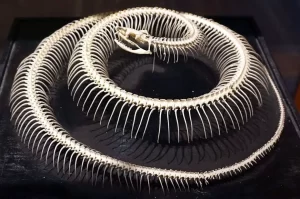
In between each rib, are muscles that help force air out of the lungs.
To breathe in, the muscles contract, and air rushes into their lungs -and to breathe out, the muscles relax and, air leaves the lungs.
While underwater, water snakes return to the surface periodically to replenish their oxygen stores and expel waste gases – with their lungs.
Water Snakes Can Stay Underwater for a Considerable Amount of Time
Although water snakes are air-breathing reptiles, they can stay underwater for a considerable period of time.
The snake species and level of activity affect how long a particular water snake can stay submerged.
A resting water snake may be able to stay submerged for several minutes while an individual who is actively hunting may need to resurface more frequently.
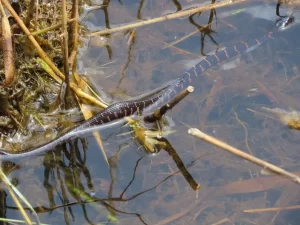
Plain-bellied water snakes (Nerodia erythrogaster) have been observed submerged underwater for several minutes, and lying in wait for prey to approach.
Can Water Snakes Drown?
Despite their various adaptations to a semi-aquatic life, water snakes can drown if they can not surface for air.
For example, if a water snake is entangled in a fishing net, the snake may drown if it is unable to reach the surface.
Some Sea Snakes Can Breathe Underwater
Water snakes are different from sea snakes. Water snakes live in or near freshwater bodies, while sea snakes live primarily or entirely in marine environments.
That said, some species of sea snakes have been found to have the ability to breathe underwater.
A team of researchers analyzed the bodies of two blue-banded sea snakes (Hydrophis cyanocinctus) – and discovered a gill-like network of blood vessels in the animals’ heads.
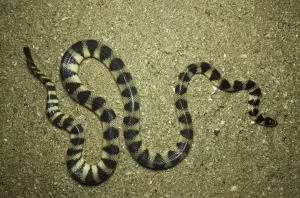
This complex system of blood vessels is known as a modified cephalic vascular network (MCVN).
It is located just under a broad area of skin between the snout and the roof of the snake’s head.
While the MCVN is structurally very different from the gills of fish, its function is similar. It provides a large surface area packed with oxygen-depleted blood vessels.
The oxygen-poor blood in these vessels is able to absorb oxygen from the surrounding water – through the skin.
The blood oxygenated blood is then carried to the brain – very similar to how a fish’s gills work.
In this way blue-banded sea snakes use the top of their head, as a sort of gill, to breathe underwater.
This ‘skin breathing’ is known as cutaneous respiration, and is very unusual for reptiles, because their skin is thick and scaly.
Conclusion
Water snakes are often found close to bodies of fresh water. However, some species also travel long distances away from water.
These snakes find a large portion of their prey in the water. They hunt tadpoles, small fish worms, leeches, salamanders, and many other aquatic animals.
While hunting for prey, water snakes often dive underwater, and can stay submerged for several minutes before resurfacing.
Despite their semi-aquatic lifestyle, water snakes generally can not breathe underwater. Rather, they hold their breath and return to the surface periodically to replenish their oxygen stores and expel waste gases – with their lungs.
Featured image credit: Kevin Ricker (CC BY-NC 4.0 DEED)
Sources:
By Douglas Mader, M.S., DVM, DABVP. Snake Anatomy: Know your snake inside and out with this snake anatomy introduction. (PDF).
Palci, A., Seymour, R. S., Nguyen, C. V., Hutchinson, M. N., Lee, M. S. Y., & Sanders, K. L. (2019). Novel vascular plexus in the head of a sea snake (elapidae, hydrophiinae) revealed by high-resolution computed tomography and histology. Royal Society Open Science, 6(9), 191099. https://doi.org/10.1098/rsos.191099
Hi, my name is Ezra Mushala, i have been interested animals all my life. I am the main author and editor here at snakeinformer.com.

